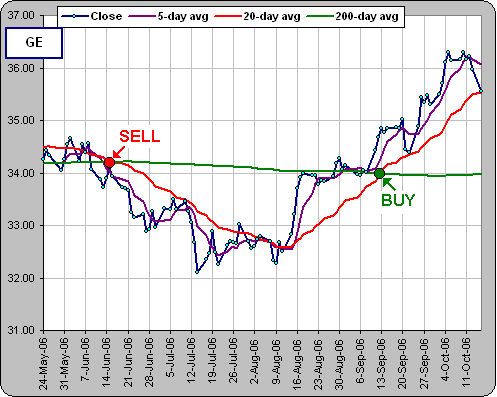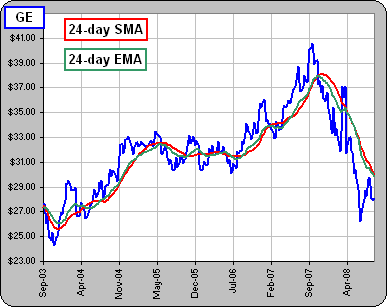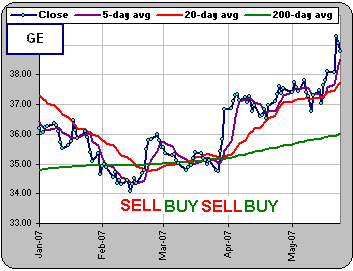| When to Buy & Sell ... Buy & Sell Indicators |
Having settled on some fool-proof portfolio, with components that don't have a high correlation, with smallish volatility that let's you sleep at night, that's diversified, that's ...
>Your point?
Well, you have choices:
- You can let the portfolio remain, untouched (except, perhaps, for occasional rebalancing to maintain a desired allocation and, of course, adding additional monies).
- You can buy and sell assets when conditions seem favourable.
... or maybe a collection of mutual funds that cover all the bases
... or maybe an Index Fund that involves a jllion diversified stocks.
You just rebalance from time to time and add additional money with each paycheck.
(See Poor Joe)
Others like to buy and sell assets when they get Buy or Sell signals.
>Huh?
There are a jillion rituals that suggest when to buy and when to sell.
For example, you look at the average stock price over the past 200 days. That'll give some sort of "baseline" price, based upon the performance over some 10 months.
Then you look at the average stock price over the past 20 days. That'll follow the current price fairly closely without being greatly influenced by random swings.
When the 20-day average crosses the 200-day from below, that's a bullish sign and you Buy, and when ...
>Why?
The implication is that the faster 20-day moving average is rising above the "baseline" and you should jump on the bandwagon as the price goes up.
| On the other hand, if the 20-day average crosses the 200-day from above, that's bearish and you Sell.
>And that always works?
>And I'm buying and selling like crazy!?
|  |
>Okay, I get it.
Another thing: those moving averages give as much weight to an old stock price (200 days ago, for example) as they do to a recent price (like today's price).
For that reason, it's nice to weight the recent prices more heavily ... and the Exponential Moving Average does that.
We first pick some number slightly less than 1, call it α (alpha), then consider the weighted Sum:
S = Pn + α Pn-1 + α 2 Pn-2 + α 3 Pn-3 + ...
where the set of Ps are the stock prices, with Pn being the most recent.
For example, if α = 0.92 then we'd have:
S = Pn + (0.92)Pn-1 + (0.846)Pn-2 + (0.779)Pn-3 + (0.716)Pn-4 + ...
See? The earlier prices get multiplied by smaller and smaller numbers.
>That's the EMA?
Not yet. If all the prices were the same... and equal to P, we'd get:
S = P (1 + α + α 2 + α 3 + α 4 + ... ) = P / (1- α)
since the infinite sum of powers of α adds up to 1/(1 - α ).
For a constant price P, our EMA should equal that constant price, so we take: EMA = (1 - α ) S.
| EMA = (1 - α ) [Pn + α Pn-1 + α 2 Pn-2 + α 3 Pn-3 + ...] |
You don't. You just keep calculating the EMA as the days go by ... and the sum goes back to the first price, when you started calculating.
However, there's a simpler ritual:
- Start with EMA0 = P0 ... where P0 is the price when you start your calculations
- Each day you calculate a new EMA, generating a sequence EMA1, EMA2, EMA3 etc., like so:
- EMA1 = (1 - α )EMA0 + αP1
- EMA2 = (1 - α )EMA1 + αP2
- EMA3 = (1 - α )EMA2 + αP3
- etc.
| EMAn = (1 - α )EMAn-1 + αPn |
|
So you pick a number of days, like 24 and use α = 1 - 2/(1+24) = 0.92.
In general: use α = 1 - 2/(1+N) to get an N-day EMA. >Why?
Anyway, now you can look for crossings of various Exponential Moving Averages
>And that's how you decide when to Buy and Sell?
>Hundreds?
>And they all work?
|  |
See:
- Moving Averages
- more on Moving Averages
- more on Moving Averages
- Bollinger Bands
- Buy & Sell calculations
- What's hot?
- Williams %R
- Zweig 4% rule
- ADX
- Aroon Indicator
- Traffic Lights
- Candlesticks
- Point & Figure charts
- Elliott Waves
- Trends ... and when they end
- Gann charts
- Pivot Points
- Momentum
- Raff regression
- Stutzer Index
- Donchian Channels
- Buy/Sell and Daily Stock Activity
- Various stuff
- Other Moving Averages
- Another EMA: gEMA
|
|



 to continue
to continue